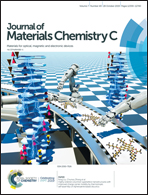The influence of intermolecular interactions and molecular packings on mechanochromism and mechanoluminescence – a tetraphenylethylene derivative case†
Abstract
Four tetraphenylethylene (TPE) derivatives 1–4 were synthesized to explore the influence of intermolecular interaction and molecular packing modes on their mechanochromism (MC) and mechanoluminescence (ML) performances. Compounds 1 and 2 modified with carboxyl groups had strong intermolecular interactions and were MC-active and ML-inactive, while compound 3 functionalized with a carboxyl ester had self-reversible MC and ML. Single crystal study of these molecules suggested that besides intermolecular interaction, molecular packing was also important for MC and ML properties. The carboxyl ester-modified 3c had weaker intermolecular interactions than 1c/2c, but it formed an intact three-dimensional hydrogen-bonded network and moderate packing density, which can efficiently block non-radiative relaxation and lead to ML. While 1c and 2c had strong molecular interactions, the molecular packing density in 1c was rather low due to its porous structure and 2c had a defective hydrogen-bonded network. These defective packings allowed non-radiative energy loss and inactivated the ML property of these two molecules.



 Please wait while we load your content...
Please wait while we load your content...